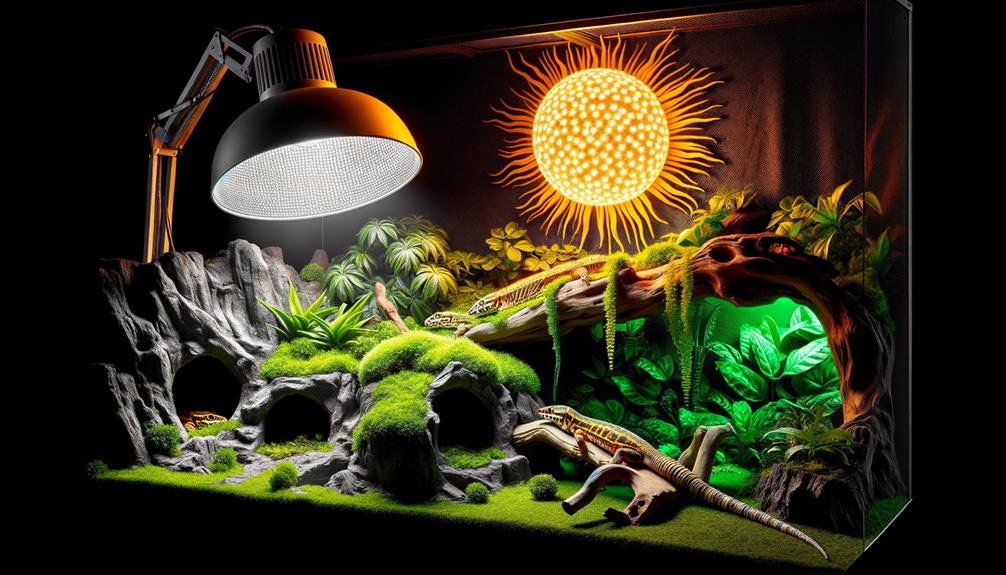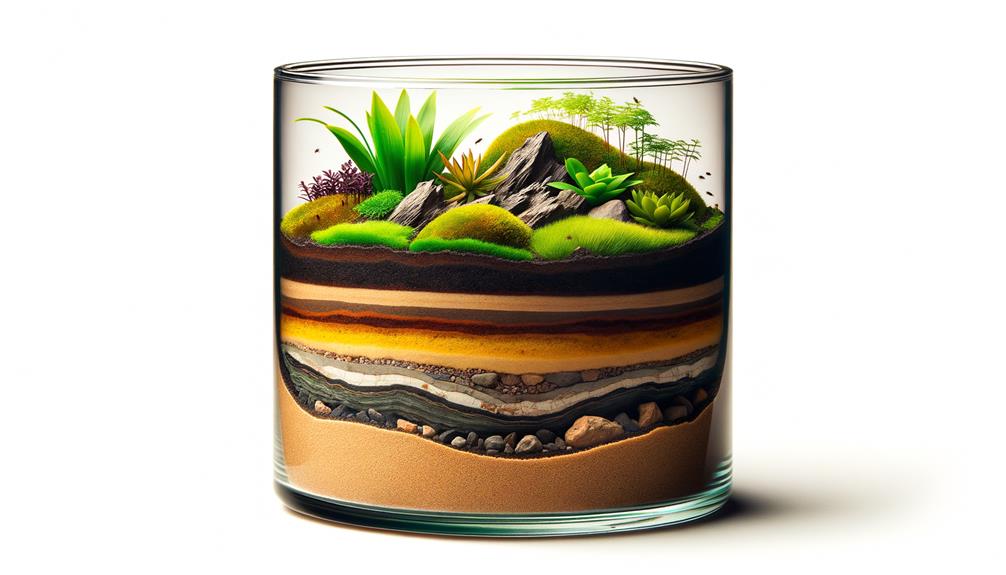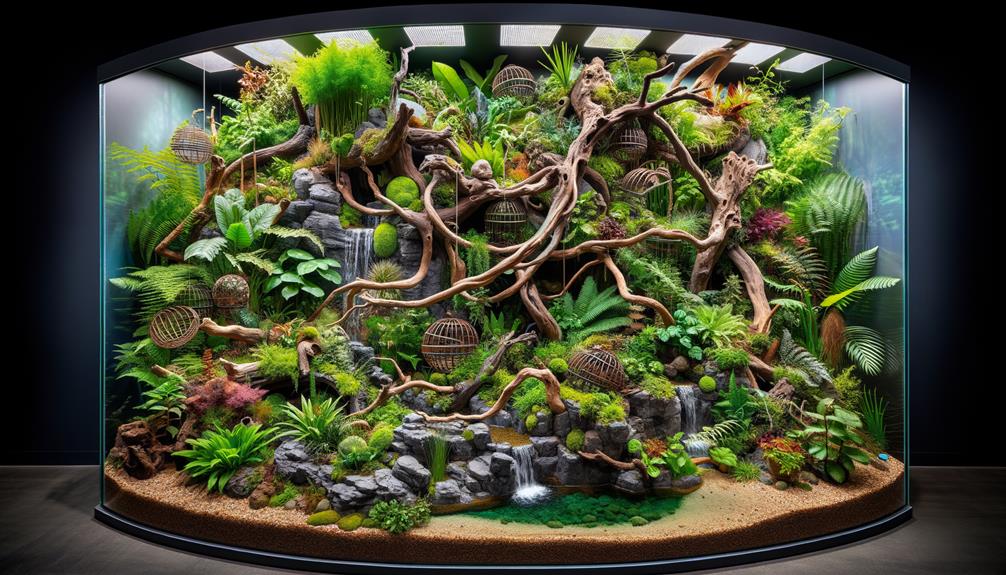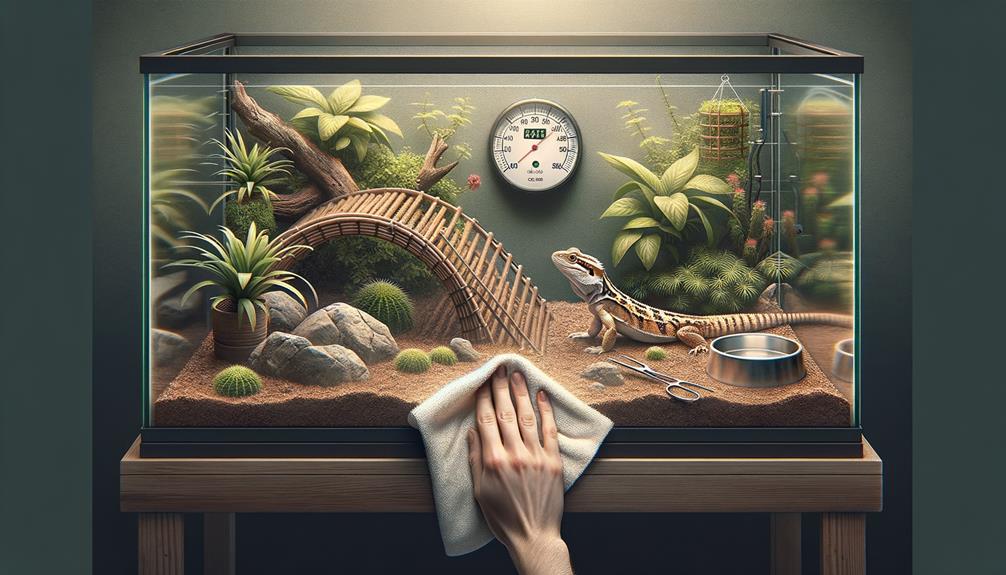Setting up a proper enclosure for your pet reptile means considering their adult size and habitat needs. Controlling temperature with a thermostat and monitoring humidity with a hygrometer are crucial. UV lighting is vital for their health, requiring both UVA and UVB light on a 12-hour cycle. I select the right substrate that mimics their natural environment, avoiding complications like impaction. Adding hiding spots and climbing structures keeps them engaged and active. Regular cleaning and substrate replacement prevent bacterial growth and maintain a healthy space. Want to learn more about creating the perfect enclosure?
Key Takeaways
To set up a proper enclosure for your reptile, start by ensuring the space is large enough to accommodate the adult size of your pet and meets its specific habitat needs. Next, install a thermostat and hygrometer to maintain the right temperature and humidity levels. Providing UV lighting on a 12-hour cycle is also crucial for your reptile's health. Choose a substrate that's suitable for your species and replace it regularly to prevent health issues. Finally, add some decorations and enrichment items like hiding spots and climbing opportunities to improve your reptile's quality of life.
Choosing the Right Enclosure
When selecting an enclosure for your reptile, it's crucial to consider the adult size of your pet to ensure they have enough space to thrive. Researching the specific species is necessary to create a habitat that meets their needs. For example, terrestrial reptiles require more floor space, while tree-dwelling species need vertical height. This ensures the enclosure matches their natural behaviors and needs.
I always make sure the enclosure has a secure locking mechanism, especially for snakes, to prevent unexpected escapes. Understanding the unique needs of your reptile is vital. For instance, a bearded dragon requires a different setup compared to a chameleon. The substrate, or material lining the bottom of the enclosure, should be chosen based on the species' natural environment. Sand, soil, or bark might be suitable depending on your reptile.
The enclosure should also support the right temperature and humidity levels, which are critical for your reptile's health and well-being. A well-chosen habitat not only keeps your reptile safe but also makes them feel at home. By paying attention to these details, I can create an enclosure that promotes my reptile's freedom and natural behavior, providing them with a comfortable and healthy environment.
Managing Temperature and Humidity

To ensure my reptile's well-being, I closely monitor and manage the temperature and humidity levels within their enclosure. This is critical for their health, as each species has distinct requirements. I use a thermostat to keep track of the temperature, making sure it falls within the recommended range for my reptile. A hygrometer helps me measure and maintain the appropriate humidity levels.
I manage these critical factors in the following ways:
I consistently monitor and control the enclosure's temperature using a thermostat.
A hygrometer helps me keep an eye on the humidity levels, adjusting them as needed.
I provide a designated basking area with a heat source, allowing my reptile to regulate its body temperature.
I research my reptile's specific requirements to ensure their environment meets their unique needs.
Each reptile has distinct temperature and humidity requirements, so it's crucial to research and cater to those needs. This attention to detail helps create an environment where my pet can thrive. Proper temperature and humidity management are vital for the overall health and well-being of my reptile.
Lighting and UV Requirements

Proper lighting and UV exposure are vital for my reptile's health and well-being. UV lighting plays a crucial role in creating an ideal habitat, impacting everything from their mood to their ability to thrive. Reptiles need both UVA and UVB lights, which serve different purposes. UVA regulates feeding schedules and mood, while UVB is necessary for vitamin D3 synthesis, essential for calcium absorption and overall health.
To create a natural environment, I set my reptile's UV lighting on a 12-hour day and night cycle. This consistent cycle supports their internal rhythms, promoting natural behaviors and overall well-being. Reptiles perceive UVA light, which affects not just their physical health but also how they experience their environment.
Maintaining these cycles and ensuring the right type of UV lighting helps keep my reptile active and engaged. Without proper UV exposure, they could suffer from metabolic bone disease and other health issues. UV lighting is essential for a healthy, active reptile. Achieving this balance is key to creating a thriving enclosure.
Substrate Selection

When selecting a substrate for your reptile, it's vital to consider their specific needs. Coconut husk and reptile carpet are popular options, but it's crucial to maintain them properly to ensure a healthy environment. Regular cleaning and replacement are necessary to prevent issues like respiratory problems and digestive complications.
Ideal Substrate Types
Selecting the right substrate is crucial for maintaining a healthy and natural habitat for your reptile. The substrate you choose affects humidity levels, supports natural behaviors, and even impacts soil health. Different reptile species require specific substrates to thrive, so it's essential to make informed choices.
For example, coconut fiber is a great option for many species because it retains moisture, helping to maintain proper humidity levels. Cypress mulch is another excellent choice, particularly for reptiles that need a damp environment. Paper towels can provide a simple and hygienic substrate for species with less demanding needs.
However, it's vital to avoid certain substrates like sand or gravel, which can lead to impaction, a serious health issue where the reptile ingests the substrate, causing blockages. To keep your reptile happy and healthy, consider these options:
Coconut Fiber: Retains moisture, ideal for tropical species.
Cypress Mulch: Maintains humidity, perfect for damp environments.
Paper Towels: Easy to clean, suitable for less demanding species.
Bioactive Substrates: Contains beneficial microorganisms that aid waste decomposition and improve soil health.
Choosing the right substrate ensures your reptile's habitat remains a comfortable and thriving environment.
Substrate Maintenance Tips
Maintaining the right substrate for your reptile's enclosure is crucial for their health and well-being. Regular cleaning and monitoring make a significant difference. When selecting a substrate, consider the specific needs of your reptile species. For example, sand is ideal for desert dwellers, while coconut fiber works well for tropical species. This ensures effective temperature regulation and humidity control, which are vital for your reptile's overall health.
Cleaning the substrate regularly prevents bacterial growth and odor. This keeps the environment safe and comfortable for your reptile. Avoid using cedar shavings or pine as they can harm or cause digestive issues for your reptile. Instead, opt for specialized substrates designed for specific reptile species. These substrates cater to their unique needs, creating a safe habitat.
Adding Decorations and Enrichment

Adding decorations and enrichment items to your reptile's enclosure can greatly enhance its quality of life and well-being. By incorporating elements like plants, rocks, and branches, you provide essential hiding spots and climbing opportunities, allowing your reptile to express its natural behaviors. Enrichment items, such as basking platforms and tunnels, not only mimic their natural habitat but also promote mental stimulation.
When setting up these items, stability is crucial to prevent injuries. You should securely place decorations to create a safe and engaging environment. Integrating a variety of textures and heights can make the enclosure more dynamic and interesting for your reptile.
Some key items to consider include hiding spots, such as rocks or caves, which provide privacy and security. Climbing opportunities, like branches or vines, encourage physical activity. Enrichment items, such as puzzle feeders or basking platforms, stimulate mental and physical engagement. Interactive toys, like objects that encourage exploration and play, can prevent boredom.
Remember to guarantee stability when setting up these items to prevent any injuries. By incorporating a variety of decorations and enrichment items, you can create a safe and engaging environment that promotes your reptile's natural behaviors and overall well-being.
Regular Maintenance

When it comes to regular maintenance, I prioritize cleanliness and upkeep to keep my reptile healthy. I clean the enclosure frequently, replace the substrate, and monitor temperature and humidity levels to reduce the risk of infections and diseases. By doing so, I can create a pristine habitat that supports my pet's overall well-being. Let's dive into some practical tips on cleaning frequency and substrate replacement to help you maintain a healthy environment for your reptile.
Cleaning Frequency Tips
Regular cleaning of your reptile's enclosure is vital for their health and well-being. To create a safe and comfortable habitat, establish a consistent cleaning routine. This helps prevent infections and ensures your reptile thrives.
Incorporate these practical tips into your routine:
- Weekly Cleaning: Remove waste and clean surfaces at least once a week to prevent bacterial growth.
- Substrate Replacement: Freshen up the enclosure by replacing the substrate every 3-4 weeks.
- Daily Checks: Monitor temperature and humidity levels daily to maintain an ideal environment.
- Monthly Inspection: Check lighting fixtures and decorations monthly for any damage or malfunction.
Let me know if you'd like me to make any adjustments!
Substrate Replacement Guide
Maintaining a clean and healthy habitat for your reptile is crucial. Regular maintenance of the substrate is vital to preventing health issues and keeping your pet's environment free from harmful contaminants. Depending on your reptile species and enclosure size, you should aim for a substrate replacement every 1-3 months.
Dirty or soiled substrate can cause bacterial growth, unpleasant odors, and potential health issues for your reptile. Use safe and appropriate substrate materials that are recommended specifically for your reptile species. Regular replacement helps prevent mold, parasites, and other harmful contaminants from thriving in the enclosure.
Here's a quick guide to help you determine the right frequency for substrate replacement based on different factors:
| Reptile Species | Enclosure Size | Substrate Replacement Frequency |
|---|---|---|
| Bearded Dragon | Medium to Large | Every 2-3 months |
| Leopard Gecko | Small to Medium | Every 1-2 months |
| Ball Python | Medium to Large | Every 2-3 months |
| Corn Snake | Small to Medium | Every 1-2 months |
| Red-Eared Slider | Large (Aquatic) | Monthly |
Frequently Asked Questions
What Do You Put in the Bottom of a Snake Tank?
I use aspen chips or a textured mat as the substrate in my snake tank. Occasionally, I add moss to create a burrowing environment. It's crucial to select a substrate that prioritizes my snake's comfort and supports its natural behaviors.
What Do Corn Snakes Need in Their Tank?
Corn snakes require specific elements in their tank to thrive. A secure top is crucial to prevent escape, while a basking light and heat mat provide the necessary warmth. A cozy substrate, such as aspen or cypress mulch, helps maintain humidity and comfort. Hiding spots, like rocks or commercial hides, give the snake a sense of security. Fake plants add visual appeal and can provide additional hiding spots. Finally, a water dish is essential for hydration. By including these elements, you can create a happy and healthy environment for your corn snake.
How Should a Ball Python Enclosure Be Set Up?
I set up my ball python's enclosure in a 36-inch tank, creating a temperature gradient that ranges from 78 to 96°F. I use coconut husk as the substrate and make sure there are hiding spots on both the warm and cool sides.
How Do You Set up a Reptile Enclosure?
Setting up a reptile enclosure is like creating a mini-ecosystem. To ensure your reptile's comfort, start by providing a spacious environment that maintains the right temperature and humidity. Next, choose a suitable substrate and add hiding spots to help your reptile feel secure. Finally, prioritize cleanliness and regular monitoring to keep your pet healthy and thriving.



